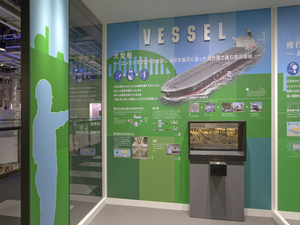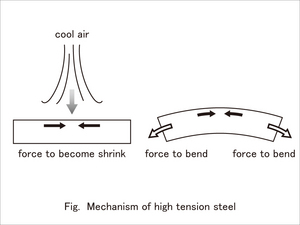Nagoya City Science Museum
TOP > Exhibition Guide > Keyword Search > Starting with "H" > high strength > Vessel
Vessel



Purpose of Exhibition
Japan relies on the importation of a lot of energy and food from overseas. Large vessels have played an active role in carrying a lot of oil and food and to export automobiles and so forth manufactured in Japan.
Large ships are able to float in the sea.
The purpose of this exhibit is to get you to understand more deeply the principle by which these vessels proceed over the oceans by floating and how they were built.
Additional Knowledge
[Buoyancy]
When gently putting an object into the water, a force equivalent to water weight, which the object pushes out, will work upward. This force is called buoyancy, which is called the "Archimedes's principle". It is a myth that Archimedes, appointed to examine if a crown was made of pure gold, discovered this while taking a bath.
If the gravity of the ship is greater than the floating power of the ship, the ship will sink. A ship floats on the sea because of a balance between its gravity and floating power.
[Force to Move the Ship Forward]
Boats advance powered by diesel engines. The engine rotates a propeller, which pushes back the sea water from the front toward the back, and the boat moves forward by its reaction.
[Ships are designed by Computers]
Large ships are designed nowadays with the help of computers. Their components are designed using three-dimensional technology. Machine tools cut steel sheets based on this data.
[Strong Steel: Steel Sheets]
The steel is made of a regulated amount of carbon involving iron. When the surface of melted steel is rapidly cooled down by blowing cool air, a force works upon the surface to become smaller.
After cooling, even if bent with great strength counterbalancing with respective strength, the steel does not break.
Thus, steel sheets called high strength steel sheets are used.
[Modular Design]
For the hull, a block is made by welding steel sheets together in a factory. Chunks of the block are welded to the next and one after another, and the final assembly takes place at the dock.
This method is called modular design. It allows us to manufacture ships quickly and efficiently.
[Technology to Bond Steel Sheets Together: Welding]
To bond steel sheets together, welding is used. Not only welding of plane surfaces, but to join more complex surfaces together, accumulated experience of "Craftsmanship" is also required.
[Production of Propeller]
Propellers have a significant impact on the energy effectiveness. Quite a few portions of the production cannot be processed by machine. Those portions are processed by hand working. The shape and accuracy of the surface processing has a significant impact on the amount of fuel consumption.
References:Shin Kurushima Toyohashi Shipbuilding Co., Ltd.
Nakashima Propeller Co., Ltd.
Article and illustration by Kouichi Mabuchi
